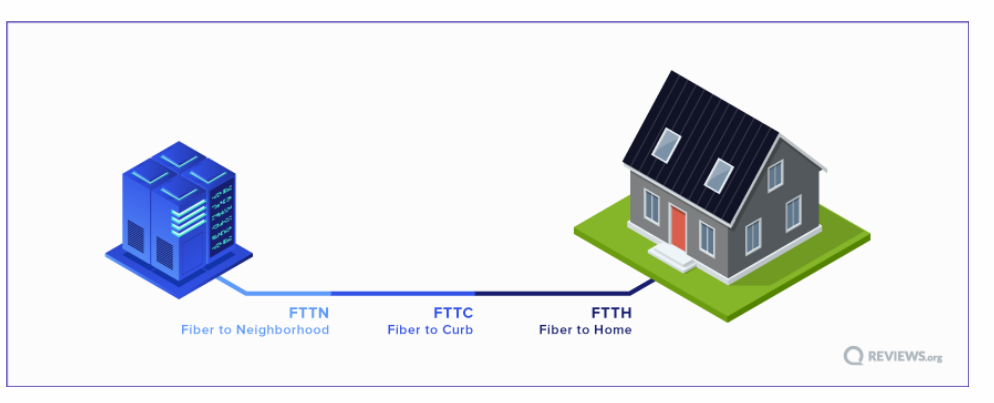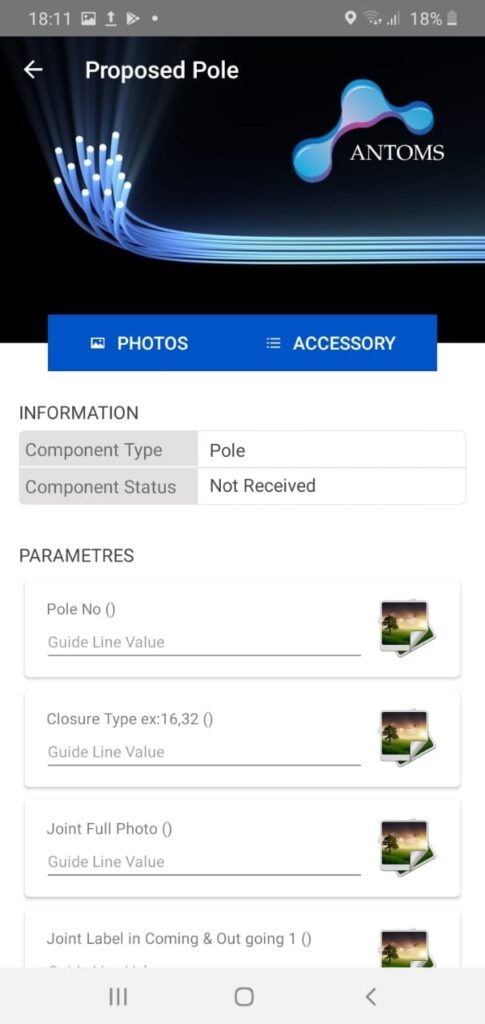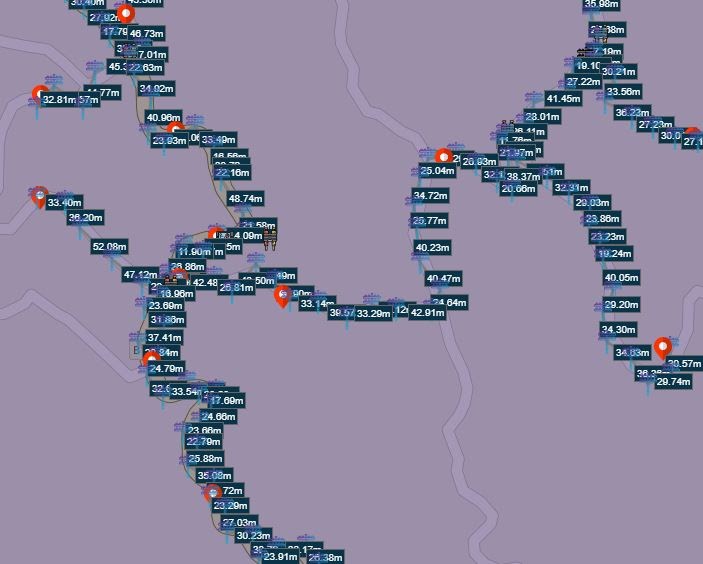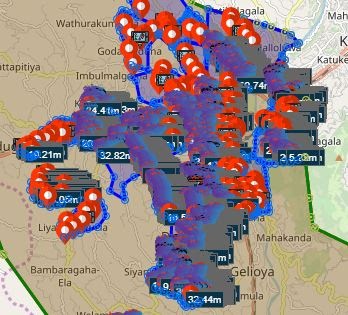By Azfa Razzaq
Background of the Study
Promising faster loading times and high-quality content streaming, Fibre Optic Internet has become the future of broadband. It can transfer data at speeds of 70% of the light speed and is becoming very popular among internet users compared to DSL internet connection. Fibre optic cables are the backbone of the fibre optic network. These cables are made up of thousands of tiny strands of fibres. These optical fibres transmit light which carries data super fast with the powerful internet networks that have higher bandwidth & lower latency. Thus, optical communication has become a popular technology used in networking and data transmission. Passive optical networks which enable the modern fibre-to-the-home network are considered as advanced access technology compared to traditional DSL networks.
The cable routing may be done underground, above ground, under the sea etc. and it is done in many ways such as;
- FTTH (fibre to the home): Fibre optic cable running directly from the Internet Service Provider (ISP) to a home
- FTTP (fibre to the premises): Fibre optic cable running directly from the Internet Service Provider (ISP) to a business location
- FTTN (fibre to the node): Fibre optic cable running to service a large area with copper ethernet cables connecting each location in the service area to the node
- FFTC (fibre to the cabinet): Fibre optic cable runs to the curb near the user with a copper ethernet cable connecting the fibre at the curb to the final location
which can be called in general as FTTx, which refers to all types of fibre infrastructures mentioned above.

The Internet Service Providers (in Sri Lanka) may outsource building fibre network infrastructure to one or several expert firms, enabling the fibre optic internet connectivity to different regions of the country. The outsourced companies will design the fibre network connection to the areas which are requested by the Internet Service Provider and implement the project by installing cabinets, poles, cable routings etc. Also, these parties are responsible for providing cable laying for home connections as well, i.e. tapping the nearest pole to the building to get the fibre connection.
In general, the outsourced companies will be carrying out the following tasks;
- Developing the infrastructure for laying fibre network connection within a specific area (eg. installing poles and cabinets, laying cables underground, connecting cables with poles etc.)
- Providing home connection using existing FTTx connection infrastructure
Why ANTOMS?
‘ANTOMS’ is a groundbreaking telecommunication web and mobile application which eases the process of designing and implementing FTTx networks. This application mainly focuses on letting the project planners, managers and field workers accomplish their planning and operational tasks in a more convenient way.
Before the implementation of ANTOMS, the whole fibre network project planning and implementation was carried out on paper. Field workers would travel location by location to collect information and would mark places where the poles and cabinets can be installed (designing the high-level design). Later the experienced planners would draft the high-level design which would take much time to approve and revert. Once approved, then again the low-level design with components and devices needed to implement the fibre network system. Once the wires and the poles are installed correctly, experienced field workers would travel location by location to check whether the installations are done accurately. Once the outsourced vendor approves, then they will inform the service provider and the service provider will have to revisit each location to verify the installations before releasing the payments. This made field workers spend most of the time travelling which incurs an additional cost too.
Now, with ANTOMS, the operation has become almost effortless. The planners can draft both the high level and the low-level designs with the optimum path suggested by the tool itself considering every geographic and artificial feature, using the application and the approvals are also automated, saving time. For implementation, the designs are pushed to the ground by engineers and supervisors’ mobile apps with a region-wise worker allocation feature. Once the implementation work is completed, the field worker will upload a set of real-time images of the installation which will be guided by the app itself and can be reviewed by both the vendor and the Internet Service Provider without visiting the site.
What is ANTOMS?
Our ANTOMS application can be used to centralize the fibre optic network laying operation for countries and service providers. It allows remote planning, designing, approving and field implementation of fibre optic networks. Furthermore, it enables remote and virtual field inspections for the supervisors. This would save time, cost and effort in project management and execution. Our application facilitates user-friendly, guided and interactive processes for the workers for better convenience.
The users of ANTOMS can be categorized as Project Manager, Project Planner, Client Admin, Super Admin, Field Worker Admin/ Supervisor, Home Connection Officer and Field Worker. The Project Manager uses ANTOMS to create new projects, to manage the entire project by approving/ rejecting designs, to monitor fieldwork and for reporting purposes. Low level and high-level designing for the implementation of new fibre network connections is done by the Project Planner using ANTOMS. This also facilitates managing, reviewing, approving/ rejecting and overriding (the tasks of the vendor) privileges to the Client Admin. The Super Admin manages the users of ANTOMS and access PM and PP features while the Field Worker Admin uses ANTOMS to monitor and manage Field Workers. The Home Connection Officer uses ANTOMS to view shared projects and upload images related to new home fibre connections via mobile application. Field Workers use ANTOMS to view shared projects and upload fieldwork images.
Thus, there are three main components in ANTOMS to facilitate above;
- Planner tool
- Project Manager (PM) tool
- Mobile application
The Planner tool mainly covers the scope of designing the High-Level Design (HLD)and the Low-Level Design (LDL) (i.e. selecting the clusters, required man-holes, required hand holes, poles, connecting the poles with wires, inserting cabinets etc.) and after doing the initial project development it can be saved and sent for the approval process.
The Project Manager tool (PM tool) can be used to create new projects, obtain saved plans and PAT, download PAT documents, edit projects, approve and reject HLD and LLD, approve and reject images or meter readings of a site sent by the field surveyor and obtain the detailed summary of executed and on progress projects.
The Mobile application which is given to the field surveyors can be used to retrieve data and upload information to the system efficiently. Images of the site, meter readings and components can be uploaded by the field surveyors. An important feature in our mobile application is that it enables geo-tagging so that the images should be uploaded within a 30m radius around the installation to avoid including pictures at false destinations.

What Distinguishes ANTOMS from the Others in the Market?
Even though a few foreign leading telco and technology companies have introduced similar systems, ANTOMS is unique and developed with special consideration given to the Sri Lankan context. Not only it consists of all the features required to execute a project remotely but it also uses and suggests the least-cost method for optimum cable routing in a given area. The mobile application provided for the field workers has a geo-tagging facility upon uploading the images which is allowed only within the vicinity of the installation (within 30m radius) by the app itself. Therefore it is compulsory for the field workers to take accurate pictures right at the working site to prove the work completion and to avoid including pictures at false destinations. Images with important details are uploaded as high-resolution images and other images are uploaded as low-resolution images automatically, to increase the efficiency of the application. Currently, over 1.5 million images (over 2TB data) are being uploaded to the system via the application by workers in field operation.
Future Development Plans
ANTOMS is on the way forward to be an Automated Fibre Network Planning System and hence we at Effective Solutions are constantly engaged in improving AI and machine learning algorithms for better performances of the application. We will be assessing where market opportunities exist for ANTOMS to do the optimum design and planning while incorporating factors such as existing infrastructure, population, maintainability, undergoing constructions and municipal council requirements etc.




